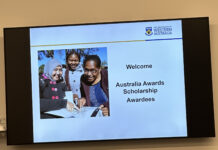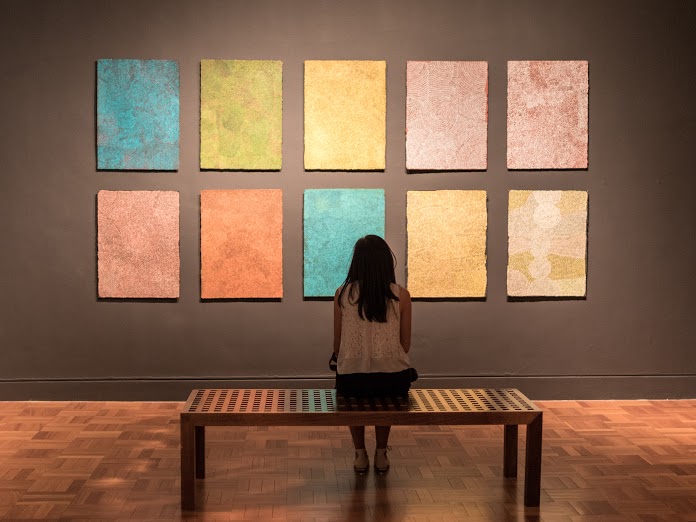The still sound of footsteps and whispered conversations echoed through a series of blank space, all bounded with white walls and crisp wooden floors. Visitors glide through the room, with sharp gazes moving from one end to the other as the dim lights set the walls aglow. The atmosphere was static but nowhere near being lifeless.
I slowly walked through a collection of centuries-old paintings, closely examining the details, the cracks that signal the ageing of the works. I was surrounded by fragments of human history, captured in forms of pigments and marbles.
Gallery visits are for me therapeutic. Not to sound pretentious, but art have given so much to me, from knowledge to appreciation, up to the building of my own principles and values.
I am one of those “hipster” students, so many of my friends would say. I major in Art History in the University of Melbourne and am the only Indonesian to take on such studies. I study the progressions of art along the ages, the material, the subject matter, the framing, the lighting, the gestures, the brush strokes. Everything that is visible in an artwork is understood in light of the invisible such as social values, allegories, moral critiques and commentary. Sounds like ‘I can bullshit my way through this degree’ kind of thing? Perhaps not that simple.
Coming to find Art History is like a falling into a rabbit hole. My adventure in wonderland began when I sought advice from my father. My moment of epiphany and the beginning of my aspiration to be a curator or patron of art didn’t come from an inspiring gallery visit , instead it simply came from a suggestion from a person I’ve been looking up to my entire life. I was confused about what subjects to take so I narrowed it down to three: international relations, politics or philosophy. My father straight up said that I have no skills in any of those fields nor do I have the passion to pursue a career in it. So he suggested art history instead.
Typical of any newbie first year students, I thought it was a study of visual arts. In high school I took a visual arts subject but ended up writing more about my artworks than making one. With that in mind and thinking that art history maybe a wise choice to take, I went ahead and took the subject Modern Art: Politics of the New. I can never forget the exact title of this subject and how much it influences my life today. From the moment I sit on the first lecture, I was sold. I did not understand a single thing my lecturer said. Several familiar names popped up, such as Picasso, Warhol and Duchamp, but it was challenging nonetheless as I have no prior knowledge of arts at all. One thing I know for sure stepping out of that first lecture is that the world of the arts is as confusing as ever but nothing short of exciting.
Eager to learn, I started to visit the art galleries in Melbourne to see the artworks in the flesh. I would spend hours going around a gallery and would visit at least once a week. I also noted that each visit, even to the same gallery, is a different experience. The more I know, the more I could appreciate the works. Art for me became less and less vague.
Going through the subject, I struggled. The readings were written in an archaic language, dating back to centuries ago. I had to look up the terms every once in a while and read through the texts three times just to wrap my head around it. Even then I still couldn’t understand the theories. Writing wasn’t any easier as the writing style is neither direct nor descriptive. You would think writing about artworks is simply describing and inscribing meanings into the visual details. It is not. Writing art history is far beyond that, it is a rabbit hole on its own.
With a mediocre grade to pass the subject, my art history major began. I am currently in the final semester of my bachelor degree, having learned all the nitty-gritty of the Renaissance to the Modern and Contemporary arts, yet I know my knowledge is still far from the entire scope of the arts. I still often get confused.
You may notice that I get confused a lot taking this “unusual” major. People would ask me ‘Where do you go after this? What prospects are out there? Are you planning to return to Indonesia?’ I drew a fine line to cope with my confusion by remembering why I take the major in the first place.
Art is a language not everyone can understand, but definitely a language that one could appreciate. As humans we have this need to understand everything. Once we don’t understand something, we simply reject it. Typically with modern art, spectators will get angry over a simple work and comment, “I could do this!”, an oft-heard sentence which initially annoyed me. Now that I can see the bigger picture, I guess it is a very human response. We always want to understand in order to accept or appreciate.
Art history teaches me to appreciate life and all its confusion. It teaches me the values of life. Perhaps a thing or two I learned from the arts is that defining what should be will always be a limitless action as it is always changing and nonetheless subjective. As I stand here in the gallery, experiencing these transformations of art in a millennium far after their makings, I realize that artists are as much human as I am today. They are social beings of change, and this inevitably transcends in their works. Art is never definite. Humans are never definite.
I have talked about the past and the present of my journey. How I got to art history may be of chance, but still, it shapes who I am today, it builds my character as a social being. As for the future, I have abstract thoughts on where my degree will take me.
The art world is an ‘elite’ jungle. It is highly competitive, strongly academic and incredibly subjective. Growing up in Jakarta, I didn’t have much access or knowledge of either national or international art. My parents would take me to galleries in Bali and private collections around Jakarta and Bandung, but all I can remember is their poor maintenance and lack of labels. It is true that the more curious and knowledgeable you are about art, the more you can appreciate it. The problem is that Indonesia offers no kind of platform for people to even be curious about art. There are only three Indonesian art history books published to date, the most recent in 1999.
One of the Indonesian artists, Eko Nugroho, has made his career internationally, as reflected by his designs for Louis Vuitton and his installations being displayed all over the world. The value of his artworks at the world’s leading auction house Christie’s surpassed many Asian artists. Yet, when I asked Indonesians including many of those self-proclaimed “patron of the art”, so few know of his existence. How can an Indonesian artist be appreciated more overseas, outside of his home country?
These are the gaps I want to close in the future. I aspire to find the roots of Indonesian Art, how it has come about, and its international influences from the Renaissance all the way through the Modern and Contemporary. And when I do, I plan to publish it so that everyone, not only Indonesians but also the whole world, can at least have access to understanding art.
The number of art institutions, communities and spaces are increasing over the past few years, especially in Jakarta and Yogyakarta. There are plenty of opportunities for the art world to shine its spotlight on Indonesia. However, we have a lot of work to do before that could happen. A good archival documentation over the years is a crucial first step. Certainly, I have no doubts on the talent and rich culture that Indonesia has to offer.
Reflecting back on my journey in the rabbit hole I call Art History, I realise that I’m riding on a time machine. The past was about how I got to choose art history, the present is me graduating in less than three months and the future is, perhaps, returning to Indonesia once I’ve made my way through as an International Curator. Just like artworks, my life and journey down the rabbit hole is a work of art in itself. It has the ability to capture the fleeting nature of time, and to pause it for a moment and a lifetime. It is bringing the past to the present in an environment that aspires for the future.
Photo by the author
Edited by Hadrian Pranjoto










